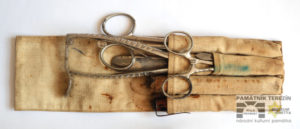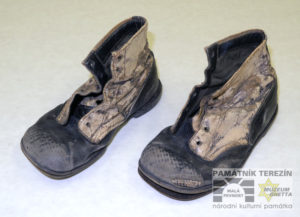
A set of surgical instruments from the Police Prison in the Small Fortress, probably the property of a surgeon-inmate, Terezin Memorial, PT 14139.
In the second half of 2017 the Terezín Memorial staged an exhibition offering its visitors a very interesting insight into the Memorial´s collection – this time a total of 66 most interesting new arrivals from the period 2010 – 2016 went on display from the total amount of 513.
The exhibits featured worthwhile works of art and historically valuable collection items from the wartime and postwar eras. Most of the wartime exhibits came from the Terezín Ghetto. An exception to the rule was a painting depicting a book-binding workshop in the Litoměřce prison. On the other hand, artworks from the postwar period were quite diversified in their subject matter. On display from the collection of 3D exhibits were objects previously owned by people imprisoned in the concentration camps (Mauthausen, Ravensbrück and Buchenwald), in prisons (Police Prison in Terezín´s Small Fortress, in Mladá Boleslav), and in the Bernau penitentiary, two exhibits also came from the Terezín Ghetto.

Children´s shoes worn in the Terezín Ghetto by Petr Dadák (born in 1942). He was deported to Terezín from Ostrava in March 1945 in a transport AE 6. He stayed in Terezín with his mother until the ghetto´s liberation, Terezin Memorial, PT 14298.
The acquisition policy of the Terezín Memorial’s Department of Collections is focused primarily on works of art and objects made in the Jewish Ghetto in Terezín and in the Police Prison in the Small Fortress in Terezín. These are mainly items used by inmates as well as their prison guards or objects that formed part of the Ghetto buildings. However, the whole gamut of items in the Terezín Memorial´s collection is much larger, both in historical and thematic terms. In addition to the above-mentioned thematic fields, the collection also comprises works of art created during the 1920s and 30s in response to the advance of fascism and Nazism, as well as works by artists pointing a cautionary finger at violence and the danger of war in today´s world. The 3D objects kept in the Memorial´s collection are not solely connected with Terezín, some of them illustrate the life of inmates in many other concentration camps, prisons and penitentiaries.
Up to this day, the Terezín Memorial still succeeds in acquiring works of art and 3D objects from the estates of former prisoners. New arrivals mostly come from the children and grandchildren of those who had passed through the repressive facilities during Nazi persecution. Newly acquired items are restored, conserved and then displayed at exhibitions or are loaned to other museums for their own displays.
Se


